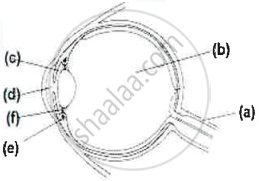Advertisements
Advertisements
प्रश्न
Write scientific reason.
The movie cannot be enjoyed if seat of a viewer is too close to the screen in the cinema.
उत्तर
- The nearer someone is sitting to the screen of the cinema hall; the more is the intensity of light falling on the eye.
- Thus, the pupil has to contract a lot, which causes a strain in the eye.
Hence, one cannot enjoy watching a movie from a very short distance from the screen in a cinema hall.
APPEARS IN
संबंधित प्रश्न
List the parts of the human eye that control the amount of light entering into it. Explain how they perform this function.
The human eye can focus objects at different distances by adjusting the focal length of the eye lens. This is due to ______.
Explain the following:
Mechanism of generation of light-induced impulse in the retina.
Name that part of the eye which is equivalent to the photographic film in a camera.
What changes the shape of lens in the eye?
Give the scientific names of the following parts of the eye:
a clear window at the front of the eye.
Fill in the following blank with suitable word:
The part of eye sensitive to light is...................
What change is made in the eye to enable it to focus on objects situated at different distances? Illustrate your answer with the help of diagrams.
Explain the functions of the following parts of the eye:
(i) cornea
(ii) iris
(iii) pupil
(iv) ciliary muscles
(v) eye-lens
If you walk from a dark room into sunlight and back again into dark room, how would your pupils alter in size? What makes this happen?
The size of the pupil of the eye is adjusted by:
(a) cornea
(b) ciliary muscles
(c) optic nerve
(d) iris
Suggest how your irises help to protect the retinas of your eyes from damage by bright light.
After testing the eyes of a child, the optician has prescribed the following lenses for his spectacles:
Left eye : + 2.00 D
Right eye : + 2.25 D
The child is suffering from the defect of vision called:
(a) short-sightedness
(b) long-sightedness
(c) cataract
(d) presbyopia
Name two animals having eyes:
one the sides of the head.
The region in the eyes where the rods and cones are located is the
Differentiate between members of the following pair with reference to what is asked in bracket.
Rod and cone cells (pigment contained)
Mention if the following statement is true (T) or false (F) Give reason.
Sometimes medicines dropped into the eyes come into the nose and even throat
With reference to the functioning of the eye, answer the question that follow:
What is the shape of the lens during distant vision?
Name the following:
Short sightedness.
Give the main function of the following:
Fovea centralis
Give the main function of the following:
Retina
Differentiate between:
Vitreous humour and Aqueous humour.
Name the following:
The most sensitive region of the retina.
Name the following:
The innermost layer of the eye
State the Function:
Aqueous humour
State the Function:
Vitreous humour
Complete the following sentence with appropriate Word
The aperture in the eye through which light enters is the:
Assertion: Blind spot is a small area of the retina which is insensitive to light where the optic nerve leaves the eye.
Reason: There are no rods or cones present at the junction of the optic nerve and retina in the eye.
We cannot distinguish colours in dim light. Explain giving suitable reasons.
______ is a transparent layer.
Which cells of the retina enable us to see coloured objects around us?
Match the following:
| Column - I | Column - II | ||
| 1 |
Retina |
a | Pathway of light |
| 2 | Pupil | b |
Far point comes closer |
| 3 | Ciliary muscles | c |
near point moves away |
| 4 | Myopia | d | Screen of the eye |
| 5 | Hypermetropia | f | Power of accommodation |
Match the following:
| Column - I | Column - II | ||
| 1 | Retina | a | pathway of light |
| 2 | Pupil | b |
far point comes closer |
| 3 | Ciliary muscles | c |
near point moves away |
| 4 | Myopia | d | screen of the eye |
| 5 | Hypermetropia | e | power of accommodation |
Match the following:
|
Column - I |
Column - II | ||
| 1 | Retina | a | Path way of light |
| 2 | Pupil | b |
far point comes closer |
| 3 | Ciliary muscles | c |
near point moves away |
| 4 | Myopia | d | Screen of the eye |
| 5 | Hypermetropia | e | Power of accommodation |
Given below is a cross section of the human eye. Match the structures marked (a) to (e) with their correct functions:
Example: (f) - 6. Holds the lens in position
| Cross section of Human Eye | Functions | |
 |
1. | Protects retina |
| 2. | Regulates the size of the pupil | |
| 3. | Alters the shape of the lens | |
| 4. | Keeps the lens moist | |
| 5. | Transmits nerve impulses to brain | |
| 6. | Holds the lens in position |
Name the following:
Place of best vision in the retina of the eye.
Name the following:
Capacity of the eye to focus at different distances.
With reference to human eye answer the question that follow:
Name the part of the eye associated with the layer providing nourishment to the eye.
